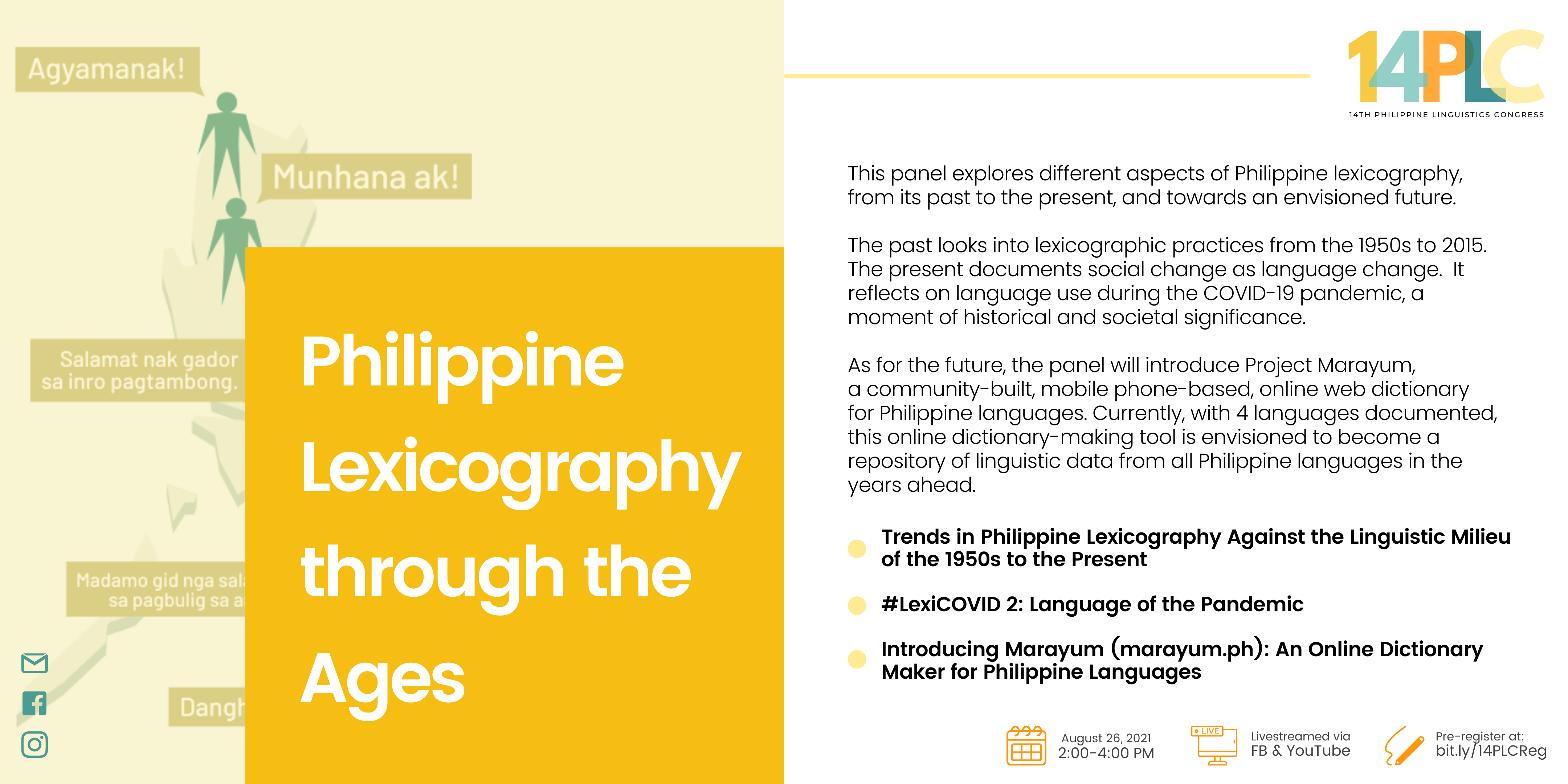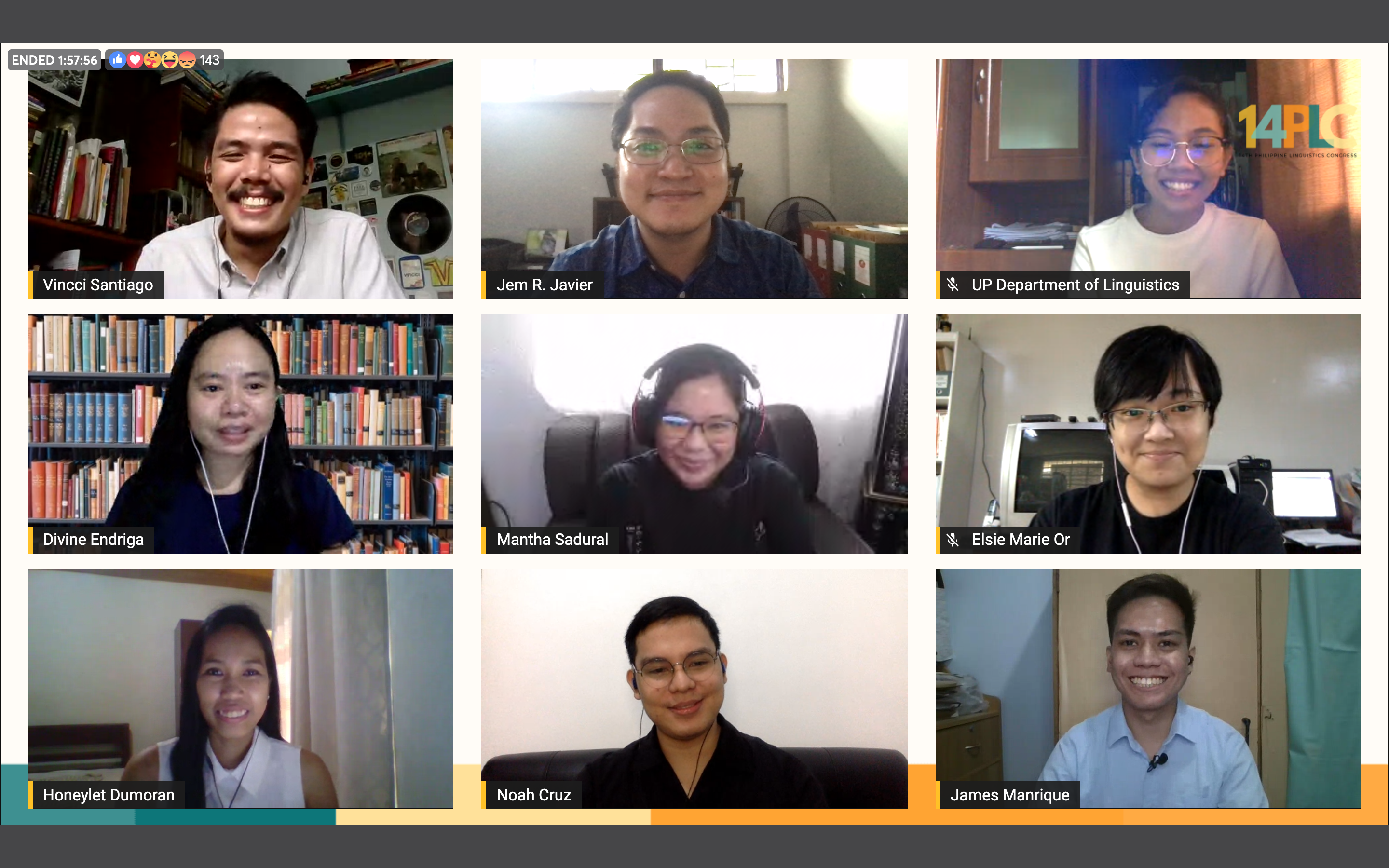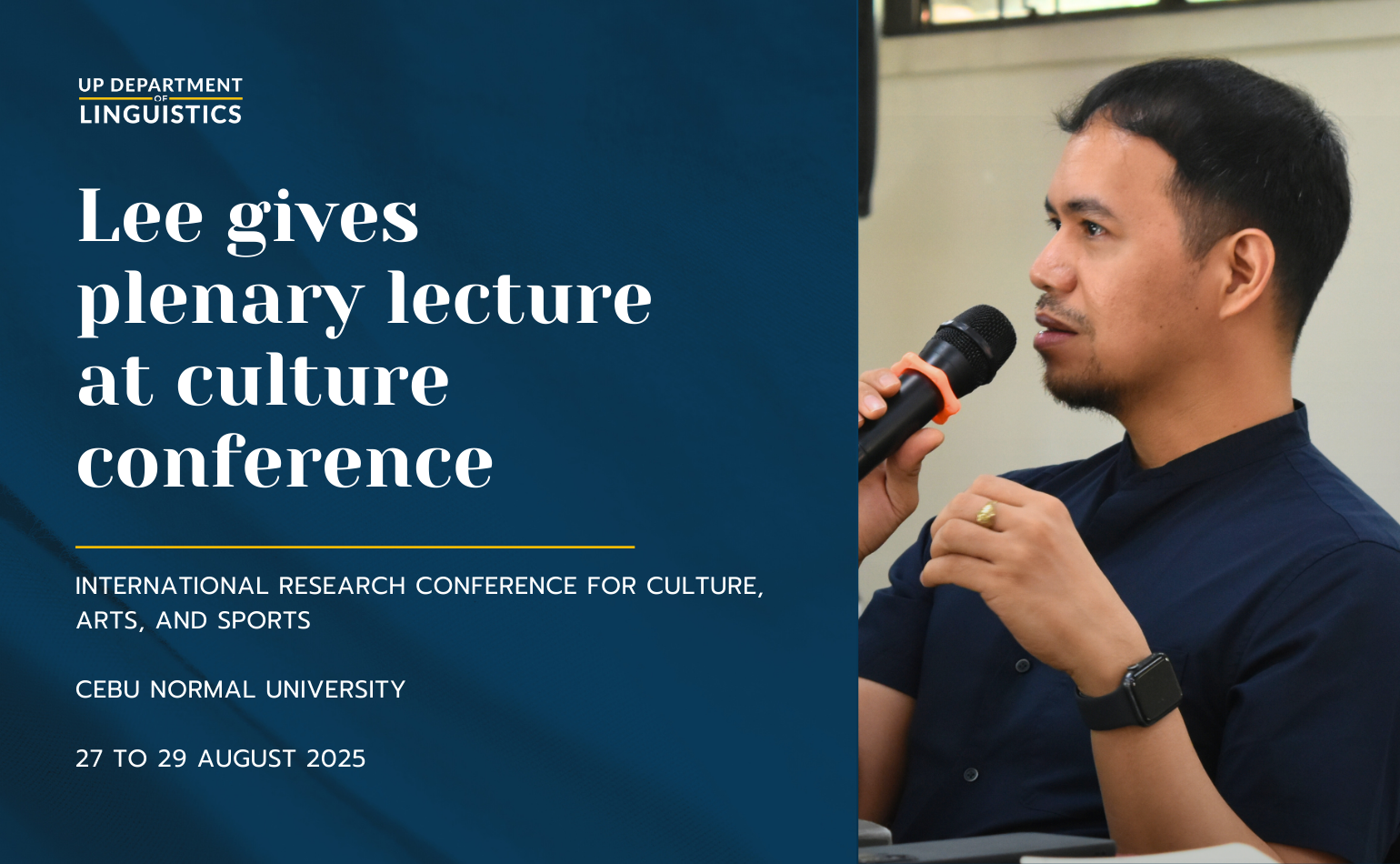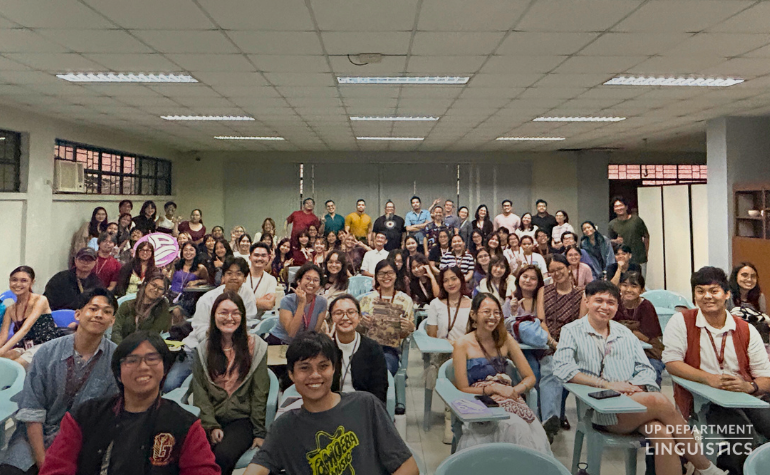
Lexicography is the field dedicated to the study and production of works such as vocabularies and dictionaries. Having more than 180 languages spoken in the country, Philippine lexicography faced transformations and challenges unique to it throughout its history. Held on the 26th of August 2021 during the 14th Philippine Linguistics Congress, the panel “Philippine Lexicography through the Ages” explored different aspects of Philippine lexicography, from its past to the present, and towards an envisioned future.
The Past: Trends in Philippine Lexicography
There are various decisions made during the preparation of dictionaries such as: What language(s) shall be involved? Will the dictionary be monolingual or bilingual? How will the individual lemma be arranged? Honeylet E. Dumoran, a PhD student of the UP Department of Linguistics, traced the development of Philippine lexicography from the 1950s to the present through a comparison of lexicographic trends.
Established in 1937, the Institute of the National Language (INL) was mandated to lead in the intellectualization of the national language. Vestiges of these efforts can be seen in the lexicography projects of the 1950s: unidirectional lexicographic works whose object language is predominantly Tagalog and metalanguage is English. The latter years of this decade also saw the rise in the number of works on non-major Philippine languages, primarily through the efforts of the Summer Institute of Linguistics (SIL). Since the SIL conducts language documentation from an ethnological tradition, their works introduced the trend of onomasiological lemma arrangement where lemmata are classified based on meaning groups.
In the late 1960s and early 1970s, the Linguistic Society of the Philippines (LSP) and the Philippine Linguistics Circle were founded and published several descriptive grammatical works exploring lexicographic themes. This time has also seen an increase in technical lexicographic works. Among these works of prime interest to linguists is R. David Paul Zorc’s “Core Etymological Dictionary of Filipino,” published in 1983, which inventories the known reconstructions of the Filipino lemma.
The 1950s to the late 1970s can be characterized by lexicographic works that are unidirectional, whereas the 1980s to the present saw a spike in bidirectional lexicographic works. Furthermore, learner’s pocket dictionaries and commercially published vocabularies increased in number.
By the late 1980s, there would be five dictionaries in Filipino published commercially, including the “Diksyunaryo ng Wikang Filipino,” the first monolingual Filipino dictionary containing more than 31,000 entries and published by the Institute of Philippine Languages (INL). In the 1990s, the average number of pages for a lexicographic work was 486, almost triple of the 1950s’ 173-page average. Among the largest volumes in Philippine lexicography is Vito C. Santos’ “Vicassan Pilipino-English Dictionary,” first printed in 1983. It contains more than 2,700 pages and around 68,000 entries. It also features grammar notes in its front matter; in the 1950s, only 1 out of 10 lexicographic works contained grammar notes.
As the grammar notes contain the description of the features of the language for which the dictionary is written, it represents the analytical tradition for grammar relevant during its period. For example, in the 1960s, the INL’s “English-Tagalog Dictionary” analyzed Tagalog verbs according to conjugations. In the “Pacific Linguistics Tagalog Dictionary” of the 1970s, verbal morphology is organized according to focus/voice.
The trends identified above arose in response to the developments in the linguistic landscape of the country created by national policies, the establishment of various linguistic organizations, and the scholarship on the Philippine languages.
Most, if not all, lexicographic works published in the 2000s are in regional languages. This is attributed to the legislation of mother tongue-based instruction and the engagement of communities in the documentation of their own languages, shifting the agency of lexicographic work from lexicographers to end users. Through this community involvement, motivations in lexicography also shifted from production of a work to protection of heritage. Dumoran concludes, the lexicographic process hence “begins where it ends, when the dictionary is handed back to the community and, with it, everything that is empowered by language.”
The Present: Language of the Pandemic
To commemorate its 98th year, the UP Department of Linguistics launched the LexiCOVID Project last August 2020. It aimed to track and record the language associated with the COVID-19 pandemic, how people made sense of the circumstances, and how the collective experience is described. LexiCOVID 2 was undertaken one year later to uncover the possible changes and continuities in how the languages used are shaped by the ongoing pandemic.
The data for the LexiCOVID Project was collected through an online survey published through the UP Department of Linguistics Facebook page.
In 2020, the top words associated with the pandemic were “quarantine,” “COVID,” “ayuda,” “lockdown,” and “social distancing.” The word “vaccine/bakuna” tops this list in 2021. This is unsurprising as the year saw the rapid development and distribution of vaccines for the immunization of people against COVID-19. Moreover, medical terms associated with immunization such as “booster shot,” “second dose,” and “comorbidity” also became widespread in mass and social media.
When asked for the emotions they associate with the ongoing pandemic, most of the respondents provided negative emotions. At the top of this list are English “anxiety” and “worry” and Tagalog “kaba” and “pag-aalala,” stemming from the fear of contracting COVID-19. English “anger” and Tagalog “galit” also dominated, directed towards the government and its failing response to the pandemic. Other emotions common among the respondents include “frustration” stemming from the inadequacy of government response and “fear” or “takot” with regard to food and job security. Among the very few positive responses is the people’s “hope” for herd immunity in the country.
For the longest time, Filipino and English have been the primary languages of national media in the Philippines. Thus, terminologies from other languages of the country are not mentioned often in the news. The survey asked for COVID-19 related terminologies used in local communities. Included in this category are the Waray word “bangot” (mask), Kankana-ey “sedey” (ritual where the movement in or out of the village is restricted), Cebuano “suob/tuob” (steam inhalation) and “amping” (take care). Various areas in the country also have local terms for pandemic-related innovations like quarantine passes: Taytay Trail in Taytay, Rizal, TRACE in Taguig City, and pink passes in Abra, to name a few.
Due to the need for physical distancing, most aspects of our lives moved to the online sphere. This shift is then reflected in the words often used in daily lives during the pandemic. Terms like “work from home (WFH)” and “virtual/Zoom meeting” are used in work-related communication. “Skeletal workforce” and “authorized persons outside of residence (APOR)” were introduced through government policy and are considered Philippinisms, with “skeleton workforce” used in International English. In education, words relating to online learning such as “(a)synchronous” and “blended learning,” those relating to learning materials like “modules,” and those relating to events such as “webinar” and “online graduation” became common among students, teachers, and parents alike. Words relating to shopping like “delivery,” “online selling,” and “e-wallet” also saw increased usage, especially in social media. New in LexiCOVID 2 are words relating to vaccination, including but not limited to “first/second dose,” “vaccination card,” “herd immunity,” and “anti-vaxxer.”
While already existing words can express thoughts and name realities, this unprecedented time also calls for the coinage of new words—coroneologisms—especially as a way to bring humor to this challenging period in history. Among these terms are “2019 BC (Before Corona)” or “pre-pandemic era,” the time before the COVID-19 pandemic; “covidiot,” someone who ignores warnings regarding public health or safety; “panini” or “Pandora,” euphemisms for the word “pandemic;” “kickvacc,” the alleged misappropriation of vaccine doses and/or the money allotted for its procurement; and “maskne,” acne breakouts caused by wearing face masks for prolonged periods of time.
The LexiCOVID project aimed to capture a part of the linguistic creativity of Filipinos exhibited during the pandemic. What emerged from the results of the survey is a record of our lives in lockdown describing our collective experience and sense-making.
The LexiCOVID team is composed of Asst. Prof. Divine Angeli P. Endriga, Instr. Vincent Christopher A. Santiago, Instr. Noah Cruz, Research Asst. Jurekah Chene Abrigo, and James Dominic R. Manrique.
The Future: Marayum, An Online Dictionary Maker
Among the languages spoken in the Philippines, 34 are in trouble, 11 are dying, and 2 are already extinct. Samantha Jade Sadural, a graduate student of the UP Department of Linguistics and the project manager of Project Marayum, showed how this project empowers speech communities, especially those of endangered languages, by giving them the tools and resources to conduct language research.
Project Marayum, from the Asi word “marayum” meaning “deep,” is funded by the Department of Science and Technology (DOST) and developed by the University of the Philippines Diliman. It is a free online dictionary maker which provides tools for the language community to create, upload, and maintain their language dictionary without the need for technical knowledge in the fields of lexicography and information technology.
As first exposed during the discussion on the trends in Philippine lexicography, dictionaries serve as a documentation of language use and study guide, helping in the transmission and preservation of a language for future generations. Aside from this, Project Marayum is motivated by the institution of Mother Tongue-Based Multilingual Education (MTB-MLE). While there are only 19 languages officially used in kindergarten and Grades 1 to 3, the Department of Education (DepEd) is open to dialog for the inclusion of additional languages. However, to be included in the program, a language needs to be documented, (i.e., through a dictionary).
To create a dictionary, lexicographers need a corpus. However, corpus, such as recorded written or spoken works for many Philippine languages, is very limited. To overcome this problem, Marayum uses practical lexicographic approach integrated with documentary lexicographic approach with community-based participatory research methods to engage language communities. To seed the dictionaries, Marayum elicited lexical items grouped by semantic fields via wordlist. These dictionaries are crafted in such a way that the linguistic needs of the community are addressed.
Marayum has four dictionaries publicly available at launch in March 2021: Asi, Kinaray-a, Cebuano (Southern Leyte) and Hiligaynon. As of August 2021, 13 additional dictionaries are being added at the backend of the project.
The revision system of Project Marayum allows editing of the dictionaries and is accessible only by the members of the language community. The native speaker-contributors can suggest edits and submit revisions for review. These edits are then submitted to a reviewer, who can either be a native speaker or a linguist, and then to a linguist-editor for approval and publication. Through this system, each entry can be attributed to all contributors, reviewers, and editors who helped build the dictionary.
Project Marayum is currently accepting applications for new dictionaries, contributors, reviewers, and editors.
Open Forum
Language is indeed dynamic and it presents many challenges in lexicography. Santiago recognized that language change is a natural process and reframes its challenges as opportunities to improve comprehension between speakers. For example, by capturing actual language use at this point in time, the LexiCOVID Project aims to help in the creation of more effective and inclusive communication strategies as we move forward from the pandemic. Sadural added that questions of whether some words should be included in the dictionary is a manifestation of the dynamism of language and should be celebrated.
During the time of the pandemic, lexicographic efforts became heavily strained. For example, the LexiCOVID Project only employed an online survey to gather data. In-person data elicitation such as what was done with Project Marayum’s seed dictionaries cannot be held due to physical distancing rules. Cruz emphasized that this means a disjunct between lexicographic data and the actual language use of some parts of the society such as those in the informal sector. This disparity in language between different social sectors and their societal effects may serve as subject of further linguistic research.
The panel was moderated by Ms. Samantha Jade Sadural and Asst. Prof. Divine Angeli P. Endriga.
The UP Department of Linguistics takes an active part in the scientific study, preservation, and promotion of the Philippine languages through teaching, field research, and publication. The projects of the Department on lexicography include Project Marayum, the LexiCOVID Project, and the creation of a dictionary on disaster-related terms in various Philippine languages, among others.
The recording of these presentations can be viewed on our YouTube channel.
Published by James Dominic R. Manrique




